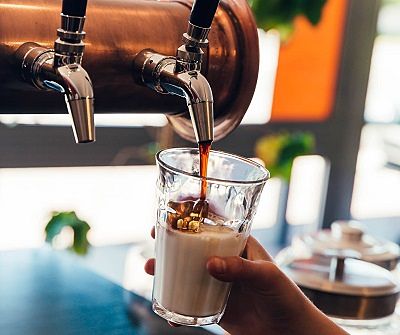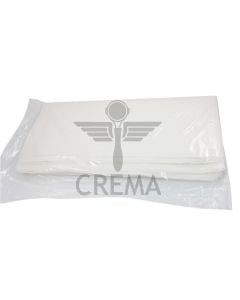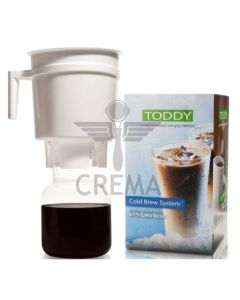How Cold Brew Coffee Could Save Cafes
- 1 Oct 2020
What are the benefits of cold brew coffee? What's involved in setting up a cold brew coffee maker? Our favourite cold brew recipes. And how cold brew could save cafes over summer...
While few of us will ever go without our critical caffeine hit, the way we want to consume it and how motivated we are to venture out into the wilderness to obtain it can vary greatly through the different seasons in a year.
Unsurprisingly, our cravings for a hot and heart-warming brew spike dramatically during the cooler winter months, as does our desire to nestle into a warm café with a cup of joe and a hearty breakfast – whether it’s dine-in or takeaway, the winter months in Australia see an observable and measureable uptick in coffee sales.
Every café, every coffee roasting house and every café consumables supplier gears up for the winter surge each year – but on the flip side, many dread the sudden drop in customers when the warmer months roll around.
In Australia we tend to experience sharp changes in temperature along with the seasons, and while we technically do have a spring and autumn – for many - summer feels nine months long. Temperatures can fluctuate from the mid-teens to the early 30s (degrees Celsius) within a day, and warmer temperatures announce themselves with dramatic flair.
So it begs the questions: How can we in the coffee industry ready ourselves for the swing in customer demand during seasonal change?

Why Cold Brew Tastes Better... And Why Chilling Hot Espresso Doesn’t Work
There is no doubt that when it comes to summer heat, Aussies are veterans at surviving the thumping we get each year. Gone are the days when hitting 40℃ raises any eyebrows in the populace, and keeping hydrated is on the top of our lists. The one major downside to the length and extremity of our hot summer months is the naturally steep decline in hot coffee consumption, and in years gone by this would be dealt by switching to iced espresso-based drinks in lieu of the morning latte.
The real issue came down to this: cold espresso can be a little bitter for some. It generally requires sweetening to be palatable for those who would normally be happy to drink a non-sweetened hot espresso coffee. When a hot espresso shot drops out of the machine, it has a very particular chemical acid profile; served hot and fresh it tastes like it should – delicious, creamy, and bold. When hot espresso cools down, the acids undergo a chemical change, converting them into different acids – these leave your brew tasting bitter and astringent.
For many hot coffee drinkers, the switch to sweetened cold espresso wasn’t considered an equal exchange and simply didn’t do it for them. It left the café industry dreading the summer sales decline, and coffee drinkers searching for an alternative to calm the caffeine crawlies.
Enter: Cold brew – the summer saviour with a better flavour. A delicious coffee experience without the acidity.
Including Cold Brew On Your Menu
The introduction and popularisation of cold brew coffee in Australia sparked a revolution. Here was a coffee that was brewed cold and served cold, keeping its acid chemical profile stable and thus delivering a consistently smooth, robust and naturally sweet brew every time.
For cafes, restaurants, bars and the multitude of other venues that serve coffee in Oz – this has been a solution worth celebrating. If you can provide Australian coffee drinkers with a high quality cold coffee option, they will switch each season with enthusiasm – they may even consume more than they usually do.
What Are The Benefits Of Cold Brew Coffee?
Save money, save time and sell more! There is so much to love about cold brew besides its yum-factor. Part of what makes it worth raving about is the ridiculous ease with which it is brewed and served. The costs involved in producing it, serving it and the profit-per-cup slightly overtake espresso coffee as a tasty bonus.
The process of making cold brew coffee involves soaking ground coffee in cold water for an 8-12 hour period. For most coffee shops and home baristas, this is done overnight purely for convenience.
- Cold Brew Is Faster To Make - The time it takes to put a brew on is roughly 5 minutes or less, and this applies irrespective of the amount you’re brewing. To put that into perspective, you set 10 litres of coffee a-brewing in 5 minutes with a commercial cold brewing system – you can make 2-3 espresso coffees in that same timeframe.
- Cold Brew Is Faster To Serve – Because cold brew is brewed in batches, the time it takes to serve it up in cups is simply unmatched by even the speediest barista on a commercial espresso machine. While it takes at least 120 seconds to make a milk based espresso coffee from grind to cup – making a milk based cold brew coffee only takes 30.
Bonus round: if you have multiple cold brew coffees on order, you simply line the cups up and pour them all at once. The more on order, the less collective time they take. That time saving means that customer gets their coffee faster, and you can get onto helping your next customer.
- Cold Brew Offers A Better Workflow – Because cold brew coffee isn’t made on your espresso machine, it means the workload of producing espresso shots for cold coffee is taken off your baristas, and your machine. It also gives you the option of making up cold brews in your cold drinks section, with your juices, smoothies and milk shakes – away from the production line of espresso coffees and reducing interruption to barista workflow.
- Cold Brew Is Cost Efficient – Cold brew coffee ends up being friendlier on the wallet overall for a number of reasons. These include reduced labour time in brewing and serving, as well as a better cost-to-profit ratio.
For example, using our espresso recipe of 22g per dose, 1kg of coffee will make 45 8oz/small sized coffees if no mistakes were made. For the same 1kg bag of coffee, you could produce 61 cold brewed coffees in the same cup size using our cold coffee brew recipe.
- Cold Brew Has A Longer Shelf life – Fresh cold brew coffee has a recommended refrigerated life of 14 days from the date of brewing. While some people may choose to drink their cold brew coffee after that date, there can be a noticeable decline in quality and flavour past the two-week mark, and as such we never sell our cold brew past that date instore.
- Cold Brew Is More Versatile – The serving options when it comes to cold brew are endless. It is proving a popular option in bars and restaurants as a smoother, sweeter alternative for espresso martinis, an ingredient in desserts and affogato, and as the go-to option for coffee smoothies and thick shakes. You can even freeze it for a frappe delivery.
With all those upsides, it pretty hard to avoid being at least a little curious about what it might do to boost your summer trade. What we love most about cold brew at Crema Coffee Garage is that we can brew it in a large batch and put it straight into our cold brew keg system – fresh brewed cold brew coffee straight from the tap for super quick delivery and a little bit of sex appeal.
How To Make Cold Brew
How To Use A Toddy Cold Brew Coffee Maker
Our Favourite Cold Brew Recipe
How To Make Cold Brew In Large Quantities
For cold brewing, there are certainly a few options to choose from out there. Many of our café partners start out small with a domestic model cold brewer like the Toddy Cold Brew System for home, or the Mizudashi Cold Brew Pot by Hario.
This gives them a chance to get familiar with the process and timing where cold brewing is concerned, and trial it with their customers to see if it’s an option that inspires demand. While in the majority of cases they find that their home model cold brewer simply can’t keep up with demand, the purchase is never a waste, because most simply use their smaller model for special single origins or keeping staff happy with their own personal brewer.
Upgrading to a cold brewing system with a bigger output capacity is easy with great set-up options like the Toddy Commercial Cold Brew System. In our own espresso bar here at Crema Coffee Garage we use two of these brewers at once to make enough to fill our 20 litre kegs, and when demand is at its peak we switch to the Toddy Pro Series Brewer. The Pro series has a jaw dropping capacity of 75 litres, but when you average summer sales of 100 litres of cold brew per week like we do – these guys are a must-have option. These are a special order item, so contact one our friendly team members to enquire if what you need is loads of cold brew coffee.
For our whole café clients we offer cold brew keg system options with taps, fridges, gas and installation services carried out by our highly experienced coffee service technicians.
How To Keep Your Coffee Sales Stable And Your Customers Smiling
If you’re dreading the rise of the iced espresso coffees – all the mucking around with ice cream, apologising to the barista as your squirm in and out to grab a shot, and running out of whipped cream – Never fear! Cold brew is here!
Cold brew is a no-brainer. It’s our saviour from caffeine deprivation this summer, while not sacrificing on flavour or quality. It’s no longer considered a quirky hipster drink option, imbibed only by coffee culture snobs and aficionados. Cold brew has been embraced and adopted by Australians with an impressive ferocity, and if you don’t have it on your menu, you can be certain that you’re neglecting a part of the market. A fair amount of coffee drinkers were only converted by cold brew, and will continue to drink it throughout winter as their chosen brew.
If you’re wondering how to get started, where to get great coffee advice and how to buy cold brew equipment that suits your needs – call the experts. The Crema Coffee Garage team roast, brew and serve their own coffee in-house and have first-hand experience in all things cold brew. Call us, email us or simply drop in to our showroom to have a chat, a coffee and a run through on how to get brewing and keeping your coffee sales stable this summer.






